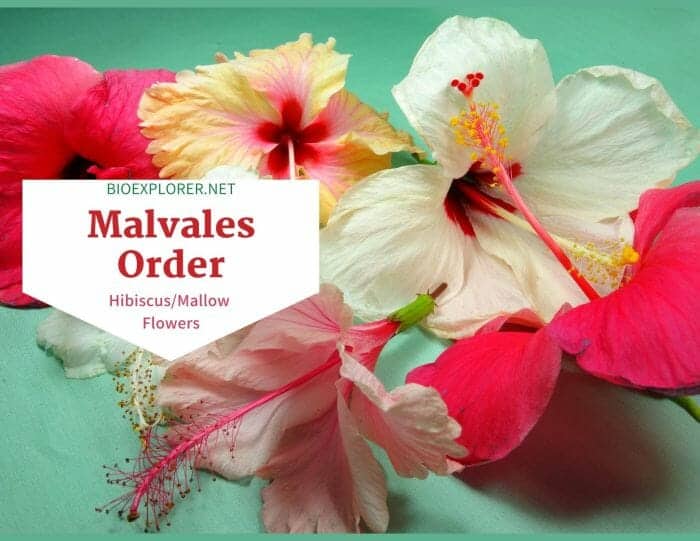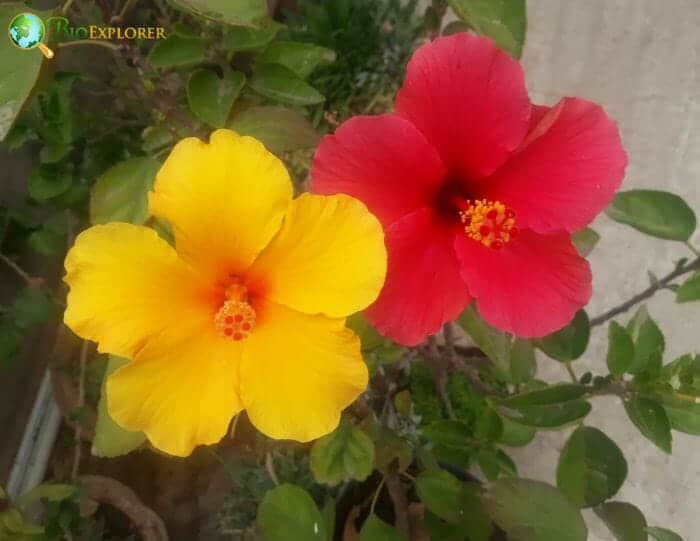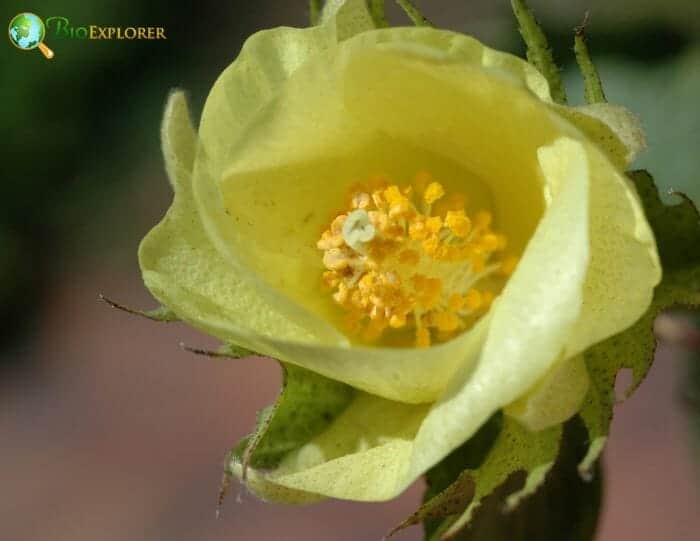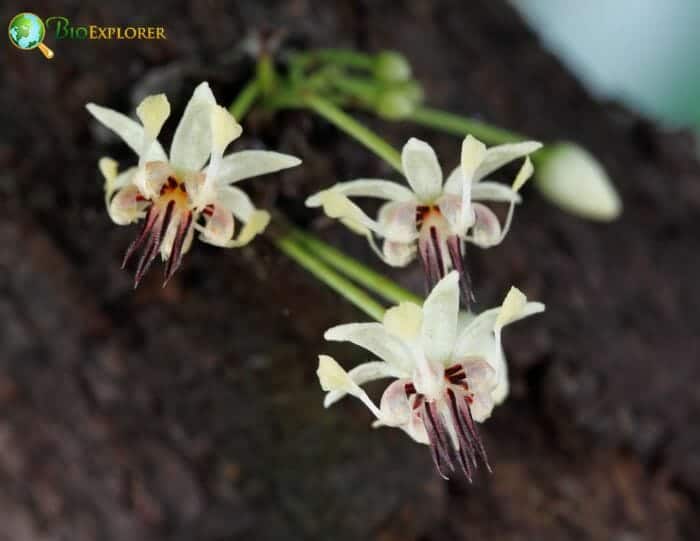
Malvales[1] is a medium-sized order, commonly called the Hibiscus or mallow order, mainly consisting of woody plants that feature showy five-petaled flowers with an epicalyx.
The members of this order are distributed across various habitats worldwide. In addition, several members hold economic importance as a source of natural fibers, food crops, and ornamentals.
The order comprises 10 families, 338 genera, and around 6,000 species.
Table of Contents
Malvales Pronunciation
Malvales Distribution

- Malvaceae – Most species are distributed in tropical parts of the world. Still, a few plants grow in temperate regions as well.
- Cistaceae, also called the rock rose family, grow in temperate or warm temperate areas, particularly in the Mediterranean region.
- Muntingiaceae is a small family distributed in the Neotropics.
- Neuradaceae is a small family of annual herbs or rarely perennial. The species of this family grow in desert areas from Africa to India.
- Thymelaeaceae consists of trees, perennial herbs, or lianas that occur worldwide except rarely in icy areas. Thymelaeceae are particularly common in tropical Australia and Africa.
- Sphaerosepalaceae is a small family of deciduous trees that grow in Madagascar.
- Sarcolaenaceae is mainly comprised of evergreen trees only known to grow in Madagascar.
- Dipterocarpaceae flowers are usually evergreen trees that prefer humid lowland tropics but are most concentrated in West Malaysia.
- Cytinaceae is a small family that grows across Mexico to Costa Rico, northern Colombia, the Mediterranean, South Africa, and Madagascar.
- Bixaceae are native to tropical America. One species is widely cultivated in tropical places, including China.
![]()
Order Malvales Characteristics

Malvales are usually recognized by the following characteristics:
- Pulvinate, spiral leaves tend to have palmate venation or at least a pair of lateral veins that emerge from the very base of the blade.
- Stellate or fasciculate hairs and their derivatives are also common.
- Usually, the bark is tough and very fibrous due to the stratified phloem.
- Sometimes, the calyxWhat is calyx?A collective term for all the sepals of a flower; the lowermost whorl of floral orgrans (Plural form is calyces). is valvate, while the corollaWhat is corolla?A collective term referring to the petals of a flower. is usually contorted.
- Usually, numerous stamens are present.
- The capsule is muricate or spiny.
- The seeds or inner side of the carpel walls are conspicuously hairy sometimes.
Cistaceae are aromatic shrubs that tend to have the following characteristics:
- Opposite leaves are joined mainly by their broad bases.
- The inner three sepals are much larger than the two outer sepals.
- When the free petals are in a bud, they are crumpled.
- There are numerous stamens.
- The seed coat is mostly gelatinous.
- The endospermis starchy.
- The embryo is almost strongly curved.
Neuradaceae consist of small herbaceous or sub-woody plants that are native to warm areas of the Sahara-Indian desert. They tend to display the following characteristics:
- Small, toothed leaves that do not have stipules.
- White flowers with petals that dry a distinctive shade of purplish color.
- The petals are spreading.
- There are ten stamens and mostly 10 individual and erect styles.
- The fruits are spiny.
Thymelaeaceae have the following distinctive characteristics:
- A highly fibrous bark.
- Usually, entire and opposite leaves do not have stipules.
- The leaves usually have relatively close, parallel venation.
- When the leaves fall off, they leave behind prominent raised scars on the stem.
- The leaf’s indumentum has unicellular hairs and is mostly silky-adpressed.
- In several taxa, there are notably flexible twigs.
- The plants, some of which are very poisonous, usually have an unpleasant smell.
- The flowers are usually arranged in heads.
- A long hypanthium in most species.
- The petals and sepals are either equal in size, or the petals are smaller.
Sphaerosepalaceae are a small family that displays an excellent level of diversity.
Some common characteristics of this family include:
- Broad, intrapetiolar stipules that almost encircle the stem.
- The flowers are primarily 4-merous, and the sepals appear in decussating pairs.
- Single seeded carpels.
Cistaceae consist of aromatic shrubs that grow in broad, sunny areas, usually on a chalky or sandy substrate. They often exhibit the following characteristics:
- Opposite leaves that have broad, even connate bases.
- The inner three sepals are contorted at times, such that the aestivation is extremely quincuncial with two outer sepals that are much smaller than the others.
- Free petals that are crumpled when in the bud and contorted in a direction opposite the three large sepals.
- Numerous stamens are usually sensitive to touch.
Dipterocarpaceae are trees that can be recognized by the following characteristics:
- Usually, two-ranked, coriaceous leaves with strong, parallel secondary veins and scalariform tertiaries are pretty close.
- Often fasciculate or stellate hairs on the leaves.
- The petioles are geniculate.
- Usually, the inflorescences are notably monochasial.
- The small flowers are pointed in the bud and have a notably contorted corolla.
- Commonly the fruits are distinctive and usually have unequal, large sepals surrounding the single-seeded nuts. However, there are other fruit types too.
Cytinaceae are achlorophyllous parasites (that lack chlorophyll). They tend to have the following features:
- Inflorescences are racemose and sometimes capitate such that the individual flowers have a moderate size and can be easily noticed.
- Basally connate perianth that is more or less spreading and exists in a single whorl.
- Extrorse stamens (staminate flowers).
- The style is quite long and extends towards the apex (carpelate flowers).
Muntingiaceae can be recognized by the following characteristics:
- Toothed, two-ranked, leaf blades with asymmetric bases and heteromorphic prophylls similar to stipules.
- Their flowers appear in extra-axillary fascicles.
- Valvate calyx.
- Shortly clawed corolla that is crumpled in the bud.
- Numerous stamens.
Malvaceae are easily recognizable even when they are sterile based on the following features:
- A fibrous bark.
- Stipulate, alternate leaves with toothed margins, ± palmate venation, and indumentum stellate to lepidote.
- Mucilage is also a common trait.
- The flowers and fruits have a combination of characters that make them distinguishable:
- The flowers usually have a valvate, connate calyx with a nectary at the base inside.
- A contorted corolla.
- Usually, numerous stamens that are connate and/or fasciculate.
- The fruit’s inner wall and/or the seed’s surface are usually hairy.
Sarcolaenaceae tend to have the following characteristics:
- The flowers of these plants are distinctive in having a massive “involucre“, sometimes an enclosing bract and an extrastaminal disc.
- Sarcolaena‘s lamina has parallel lines on the underside.
- Stellate hairs.
The Bixaceae has plants that are distinctive in having the following set of characteristics:
- Fibrous bark.
- Canals carrying red or orange exudate.
- Branches that end at the inflorescence.
- Flowers are large and have anthers that spread pollen through terminal pores.
- Leaves with palmate venation, scale-like hairs, and stipules enclose the bud.
- The ovules are produced on the ovary’s walls.
- Spiny capsule.
- The seeds have a pulpy coat.
![]()
Example Species

- Gossypium: Several species hold immense economic importance as it is a Cotton source produced commercially for the textiles industry.
- Edgeworthia, Daphne, and Gnidia: The bark of the plants is used to manufacture the highest quality paper and cordage.
- Hibiscus rosa-sinensis commonly called Chinese Hibiscus, is grown as an ornamental for its large, almost bell-shaped blossoms. The cultivated varieties yield red, white, yellow, or orange flowers.
- Abelmoschus esculentus commonly called Okra- is used as a vegetable and a thickener in food preparation.
- Theobroma cacao: Also called cacao, is cultivated commercially. The plant’s seeds, called cocoa beans, are processed to produce cocoa butter, cocoa powder, and chocolate.
![]()











